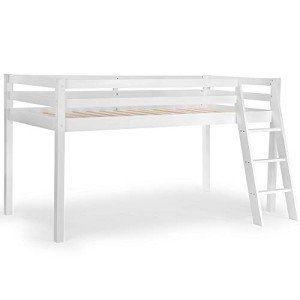Bunk Beds Sale: A Comprehensive Guide to Choosing the Right Bunk Bed for Your Home
Bunk beds have actually long been a staple in children's bed rooms, providing a mix of space-saving efficiency and enjoyable. Whether accommodating siblings, friends on pajama parties, or just taking full advantage of a playroom, bunk beds have actually ended up being an important component in modern household homes. As sales on bunk beds increase, it ends up being increasingly vital for consumers to make educated decisions when purchasing one. This article will cover the fundamentals of buying a bunk bed, from types to security features, along with suggestions for preserving the integrity of your investment.
Types of Bunk Beds
When considering a bunk bed sale, it's essential to comprehend the various designs readily available on the market. Below are the most typical types:
- Traditional Bunk Beds: These consist of 2 beds stacked one above the other, sharing a single frame. Kids Bunk Beds are frequently the most affordable alternative.
- L-Shaped Bunk Beds: This design features one bed positioned vertically and another horizontally. This plan produces additional space below the upper bed, which can be utilized for storage or a play area.
- Lofted Beds: Similar to conventional bunk beds however with no lower bed. Rather, the space underneath can be used for a desk, play area, or additional storage.
- Triple Bunk Beds: For families with a bigger number of kids or frequent slumber parties, triple bunk beds provide three sleeping areas in a space-efficient style.
- Futon Bunk Beds: These designs combine bunk beds and futon sofas. The bottom area transforms into a separate seating area, improving functionality.
- Convertible Bunk Beds: These beds can be separated into 2 private beds, making them flexible as kids's needs change in time.
Table 1: Comparison of Bunk Bed Types
| Type | Description | Space Efficiency | Extra Features |
|---|---|---|---|
| Standard Bunk Bed | 2 beds stacked vertically | High | Simplest design |
| L-Shaped Bunk Bed | One vertical and one horizontal bed | Moderate | Play or storage space |
| Lofted Bed | Raised bed with open space below | High | Work/play area |
| Triple Bunk Bed | 3 stacked beds | Extremely High | Accommodates more users |
| Futon Bunk Bed | Bunk bed with a convertible futon | High | Multi-functional |
| Convertible Bunk Bed | Can be divided into two different beds | Moderate | Flexibility & & durability |
Security Features to Consider
Safety is critical when buying a bunk bed. Below are key safety features to look for:
- Guardrails: Adequate guardrails need to be present on both sides of the upper bunk to prevent falls. They should be at least 5 inches greater than the bed mattress.
- Ladder Design: Look for tough, wide ladders with slip-resistant rungs. Guarantee that the angle is not too steep for simple access.
- Stability: Ensure the bed is built with strong products, such as strong wood or heavy-duty metal. The bed needs to not wobble when in usage.
- Weight Limit: Check the weight capacity of the bunk bed to guarantee it can accommodate the intended users safely.
- Product Safety: If possible, choose beds made from non-toxic products or those meeting safety requirements for children's furniture.
Table 2: Essential Safety Features
| Function | Description | Significance |
|---|---|---|
| Guardrails | Sides of upper bed to avoid falls | Essential for kid safety |
| Ladder Design | Strong, slip-resistant rungs | Aids safe and easy gain access to |
| Stability | Build quality to avoid wobbling | Makes sure safety and durability |
| Weight Limit | Optimum weight capability | Prevents mishaps |
| Product Safety | Non-toxic, safe products | Safeguards children's health |
Upkeep Tips for Bunk Beds
To extend the life of your bunk bed and make sure continuous security, think about the following maintenance pointers:
- Regular Inspections: Periodically inspect the structure for loose screws, bolts, or any signs of wear. Tighten fasteners as required.
- Tidy Periodically: Dust and tidy the surface areas frequently. Usage proper cleaners that won't damage the surface.
- Inspect Weight Limits: Be mindful of weight limitations, especially with older kids or adults who may want to utilize the upper bunk.
- Prevent Climbing on Guardrails: Educate children not to utilize guardrails for climbing up or playing to minimize the danger of mishaps.
Often Asked Questions (FAQs)
Q1: What is the age limitation for children to safely utilize bunk beds?A: While it varies by the maker, many advise that children under 6 need to not sleep in the upper bunk due to safety concerns.
Q2: How can moms and dads dissuade risky climbing?A: Setting clear guidelines about bunk bed use and monitoring children can help. In addition, using a bed tent can dissuade climbing while producing a fun sleep environment.
Q3: What should I think about when embellishing a space with bunk beds?A: Ensure there suffices space around the bunk bed for safe motion, and make use of the design to create personalized spaces for each child.
Q4: Is a lofted bed appropriate for older kids?A: Yes, lofted beds can be ideal for older children as long as they meet safety requirements and the child is responsible enough to utilize them safely.
Bunk beds serve a functional purpose while including an element of enjoyable to a kid's bed room. As sales of bunk beds continue to increase, careful factor to consider of types, safety features, and upkeep practices is necessary for moms and dads and caregivers. By understanding these essential factors, families can discover the best bunk bed for their home, ensuring both usefulness and security for many years to come. Whether it's for brother or sisters sharing a room or creating a comfortable pajama party space, a well-chosen bunk bed can provide happiness and functionality, making it a deserving investment.

